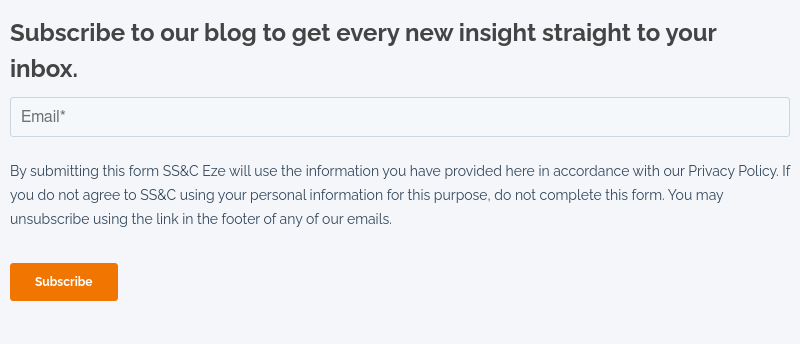OMS, EMS, OEMS. What’s the Difference? And Which Front-office Investment Technology is Right for Your Firm?
This technical evolution started with the Order Management System (OMS). The original OMS was introduced to track orders negotiated over the phone and improve paper-ticket-based recordkeeping.
As the Financial Information eXchange (FIX) protocol matured in the early to mid-1990s, second-generation OMSs added features for electronic order routing to brokers, an expansion of their capabilities that allowed them to securely automate and streamline the order routing process.
Later, Execution Management System (EMS) technology was developed to give sell-side brokers and day traders the power to participate in a fast-evolving electronic marketplace. Buy-side interest in EMS tools gained traction when vendors began offering global, multi-asset class platforms.
Today, these technologies have greatly evolved from their original form. Still, they remain central to investment firms’ ability to streamline the investment processes essential to their operation and maintain a competitive edge.

For over 15 years, I have been advising and consulting with clients on investment management technology solutions. Below, I leverage that experience to detail key functionality and what to look for in an OMS and EMS, as well as an OEMS. Understanding how each technology is positioned to help you navigate the challenges and opportunities facing today’s markets will give you the knowledge and confidence you need to make the right front-office technology decisions for your firm.
%20vs.%20Execution%20Management%20System%20(EMS).png?width=1054&height=420&name=Order%20Management%20System%20(OMS)%20vs.%20Execution%20Management%20System%20(EMS).png)
What is an Order Management System?
The OMS, typically used by investment managers, is principally concerned with front- and middle-office functions. The technology streamlines daily investment activity by automating allocations and providing position checking and advanced compliance capabilities.
To support the demands of today’s investment firms, a modern OMS offers capabilities like portfolio modeling, the ability to view P&L and exposures, order routing, and decision support, in addition to trade execution analytics functionality. And while early OMSs focused on equities, today, the OMS supports firms’ ever-expanding arrays of asset classes.
As the hub of your investment activity, your OMS must also be configurable and flexible. If the trade generation process is clunky and inefficient, it wastes valuable time and puts you at a higher risk for errors and missed opportunities.
Finally, your OMS platform must be able to grow and scale with you as your needs change – and they most certainly will. Without that scalability, you may be forced to pay for expensive upgrades, custom enhancements, or system replacements. And the total cost of ownership of your solution will outpace any savings you thought a more “affordable” option could provide.
What is an Execution Management System?
The primary goal of the EMS is to execute trades quickly. It is your firm’s direct connection to the market, designed to deliver fast and seamless access to global liquidity and provide traders more complex execution options than the OMS can offer – the tools they need to help achieve best execution. You’ll want to look for a system that offers automated trading capabilities, like rules-based order routing and advanced order types, such as conditional orders, list trading, and multi-leg orders.
In addition, today’s EMSs provide traders with more in-depth, real-time market data and insights. They can also generate fast, accurate execution reports and transactional cost analysis (TCA).
In fast-moving markets with high volumes, compliance often becomes even more challenging. A good EMS integrates compliance into every stage of your workflow to keep your trades flowing without fear of noncompliance.
Trends in Investment Management: The Power of the OEMS
OMS and EMS technologies continue to serve as the core of the investment workflow and have evolved to keep pace with new challenges facing firms: increasing adoption of global multi-asset strategies, changing regulatory and compliance requirements, and increased operational risk.
For many firms, the best way to combat these challenges is to combine the OMS and the EMS into one OEMS sharing a single, centralized source of truth. One mistake I see firms make is selecting an OMS provider that does not offer the integrated, advanced EMS functionality they need. Having to tack on a third-party EMS can lead to clunky, FIX-only workflows and increased overhead.
An effective OEMS requires a code-level integration that fully synchronizes the data between the two systems. Connecting the systems at the source code empowers users with a single elegant solution combining all the traditional features and functionality associated with the OMS and EMS without needing to swivel back and forth between screens.
Relying on one OEMS offers firms a host of benefits across trading, compliance, technology, and operations departments, including more streamlined workflows and reduced cost and risk.
Getting the Service You Deserve
No matter what technology you choose – OMS, EMS, or OEMS – be sure it comes with dependable service and support.
Make sure your vendor's service team has the investment, size, and tenure needed to provide you with the service you need when you need it. Look for a team with experience supporting firms of similar sizes, strategies, and challenges.
And when a problem arises, be sure that a live person will be available to answer your call promptly and that they will be familiar with you, the nature of your business, and your history with the technology. You don’t want to waste time being bounced from one service rep to another.
Also, ask your technology vendor whether service is included or separate from your technology cost. If it is separate, you may be stuck with unexpected or "hidden" fees, which can increase your total cost of ownership.
Dive Deeper and Select the Front-office Technology to Set Your Firm Up for Success
Investment management technology continues to rapidly evolve. While this is good news for investment firms, it can also make understanding all of the latest features and functionality and how they can help you keep pace with the challenges and opportunities facing today’s markets a lot harder.
Whether you are looking to buy, upgrade, or change your systems, SS&C Eze’s new Trading Technology Buyer’s Guide is your definitive resource for understanding how to apply the front-office technical options available to you today to set your firm up for success in the future.


